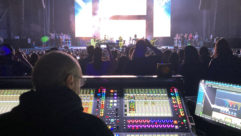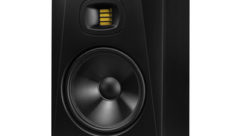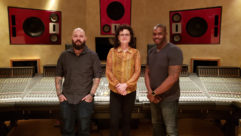
Top Tech of 2007
Dec 1, 2007 12:00 PM,
By Jack Kontney
A look back at the evolution of top new products this year.

Dolby Laboratories Lake Processor
2007 marked another banner year in the evolution of the technology that drives the AV industry. As always, new products abounded in the audio and video categories, while digital signage and life-safety systems evolved, along with the software and control systems to handle it all. With the convergence of systems technologies continuing unabated through IP control in the digital domain, it’s becoming more difficult to classify products into neat little categories. Rather, it’s all about functionality — examining the job at hand and finding a combination of mutually compatible technologies that will provide the functionality needed to handle that challenge.
The irony, of course, is that while many new products do an amazing job of solving problems and adding new abilities within existing categories, the array of choices can be confusing. While this article can’t hope to do justice to the myriad of new choices in the marketplace, it can highlight many products honored at the industry’s major tradeshows in 2007: the NSCA Innovations in Technology Awards, Sound & Video Contractor’s Pick Hit Awards for new products showcased at InfoComm, and CEDIA’s Manufacturers’ Excellence Awards. For convenience, we’re dividing them into three categories: audio, video, and beyond.

Audio-Technica SpectraPulse
AUDIO
InfoComm saw the announcement of 2007’s biggest news in audio. Amid all the worries over the potential loss of the UHF band used by conventional wireless systems, Audio-Technica called a press conference at the show to trumpet its SpectraPulse system. Operating in the wide-open 6GHz range, SpectraPulse is designed for boardrooms and meeting rooms. Rather than modulating a carrier signal, SpectraPulse sends a stream of low-level, 3-nanosecond pulses across an ultra-wideband link, where they are converted to a digital audio stream, easily connecting to recording, conferencing, or standard PA systems. Up to 14 channels (seven per rack space) can operate simultaneously, latency is only 1.1 millisecond, and the system’s frequency response is 100Hz to 12kHz — perfect for speech. While the system is inherently secure due to its unique transmission scheme, Audio-Technica also promised to offer an optional 128-bit encryption package when the system starts shipping (scheduled for December).
Audio networking is hot in the construction market, and Audio Design Associates (ADA) won an award at CEDIA for its Structured Wiring Audio Network (SWAN) system. SWAN incorporates a modular approach and innovative hardware that literally fits into the building infrastructure. In fact, an entire SWAN system can be housed in a structured wiring box. Significantly, SWAN meets Fannie Mae guidelines for inclusion in mortgages, making it ideal for any residential construction. The system can handle eight audio sources into four (and up to 48) destination zones, and it works with ADA’s family of wall-plate controllers and touchscreens. The SWAN dual tuner handles XM, Sirius, and HD AM/FM ranges. Other components include an integrated amplifier, an audio input/infrared controller module, and a zone controller integrated amplifier.
AMX also took home a CEDIA award for its AutoPatch PrecisDSP, a stereo audio matrix switcher designed for high-end audio distribution installations. Available in 8×8 and 18×18 configurations, PrecisDSP allows precise customization to meet the output needs of each destination zone. Features include integrated 10-band graphic EQ; input gain; and volume, tone, and balance controls. The AMX AutoPatch PrecisDSP includes the intuitive APGraphic EQ wizard, and it offers full compatibility with AMX NetLinx and Duet.
In a world of competing standards in digital audio networking, Whirlwind took the high road with its Protocol eXchange Platform (PXP), a system designed to help digital devices of different pedigrees to coexist within one venue. For system designers, this means that legacy products can be integrated freely with whatever new ones offer the needed functionality. The PXP is offered in three models: a CobraNet device to communicate with A-Net Pro 16, an Ethersound device to communicate with A-Net Pro 16, and a 16-channel bidirectional interface between CobraNet and Ethersound.
Dolby Laboratories, meanwhile, has taken loudspeaker and EQ technology into the digital realm with the Dolby Lake Processor, a complete signal-processing system designed to control loudspeaker systems while improving their sound quality. Supporting four-in, 12-out loudspeaker applications and eight-in, eight-out EQ schemes, the Dolby Lake handles both traditional analog and native digital I/O. Its LimiterMax loudspeaker protection system ensures full real-world loudspeaker protection, while the patented Raised Cosine Equalization system makes it easy to optimize the sound quality of the system. The unit ships complete with tablet PC software, allowing the user to listen and adjust the system from any seat in the house.
With its roots as a rackmount CD player, the Denon Professional DN-C640 slot-in network audio player takes that humble concept to its logical conclusion, with the ability to read virtually any audio format from CD (music or data) to DVD data discs, plus network audio functionality for streaming audio playlists from a laptop, server, or LAN. The unit offers direct playback of WAV, MP3, CD-DA, and WMA from a single disc. Ethernet connectivity and an onboard web GUI enable centralized control and playlist programming from any web-enabled computer. Comprehensive control options include RS-232, contact closure for GPIO, RJ-45 for Ethernet/LAN, and a full-featured infrared remote — making this unit ideal for any installation incorporating audio playback.
With teleconferencing beginning its morph into immersive telepresence systems, the need for exceptional audio in telephony has never been greater. SoundStructure is Polycom’s next-generation voice processor, which offers sophisticated DSP and acoustic echo cancellation for Polycom HDX video codecs interfacing with virtually any standard analog microphone or wireless input. With feedback control and wideband echo cancellation on every input, SoundStructure provides natural, glitch-free audio for even the largest teleconferencing systems, routing any input to any or all outputs (up to 128 channels) with its OBAM (One Big Audio Matrix) routing system.
Of course, sound quality starts at the input stage, and Yamaha nabbed an InfoComm Pick Hit award from Sound & Video Contractor with its unique ProjectPhone audio unit for both VoIP and telephony-based conferencing systems. Already available in Japan, the system uses onboard DSP to localize and track each talker at the conference table, activating those inputs to keep everyone “on mic” even when they move around. The PJP-100UH is a long, sleek desktop unit secreting an array of 32 microphones around its base and a set of downfiring loudspeakers underneath. USB and stereo analog interfaces ensure compatibility with any audio- or videoconferencing system, and audio clarity among multiple locations is ensured by broadband echo cancellation and noise reduction.
1
Top Tech of 2007
Dec 1, 2007 12:00 PM,
By Jack Kontney
A look back at the evolution of top new products this year.

L-Acoustics ultra-compact Kiva system
L-Acoustics has enabled the line-array loudspeaker concept to migrate into smaller venues with the ultra-compact Kiva system. Designed to deliver full performance in a low-profile and architecturally pleasing package, Kiva employs the same Wavefront Sculpture Technology as its bigger V-DOSC siblings. The V-shaped cabinets weigh less than 30lbs. and house a captive three-point rigging system for easy, professional installation. By combining Kiva line arrays with L-Acoustics’ compact new Kilo subwoofers, a robust, full-range music system can be specified in rooms where large line arrays are impractical due to weight or sightline limitations.
Sonance made noise at CEDIA with its acclaimed Architectural series of flush-mount loudspeakers. Available for both wall and ceiling applications in a variety of sizes, shapes, finishes, and performance levels, these loudspeakers are designed for flush mounting, becoming all but invisible in deployment. Behind the ceiling loudspeaker grilles are Sonance’s patented pivoting Sonic Eye drivers, delivering accurate, full sound regardless of the listener’s location. Both models are designed to integrate seamlessly into any room, complementing the architectural space without compromising sonic performance.
VIDEO
The state of the art in video projectors is a constantly moving target, with new advances in optics, electronics, processing, and connectivity combining with the evolution of video formats and applications to create a constantly changing landscape of products.
Christie Digital is one company that has consistently stayed at the forefront of technology, and 2007 was no exception. The Christie Roadster HD18K uses next-generation DLP chip technology, 10-bit processing, and 17,500 lumens to raise the bar in high-definition video projection. Designed for applications from corporate boardrooms and houses of worship to rental/staging, the Roadster HD18K provides 1920×1080 native resolution, variable contrast ratio, xenon illumination through Christie’s Intelligent Lens System, built-in edge blending, and two HD input channels that combine to ensure crisp, sharp images.
But Christie doesn’t limit itself to DLP. Its LX650 digital projector, a Sound & Video Contractor Pick Hit at InfoComm, refines the established 3LCD technology with innovative features that reduce cost of ownership. The air filters used to protect the machine’s 6500-lumen light engine from dust don’t require manual cleaning or changing. Instead, a cartridge of 10 filters automatically detects dust and replaces clogged filters, while an innovative cooling system ensures extended life and reduces maintenance needs. The LX650 accepts all current HDTV and DTV inputs, with input compatibility for XGA through UXGA. Its 6500-lumen output offers 90-percent brightness uniformity, and the unit accepts graphics, computer data, and video with equal aplomb, making it a natural fit for house of worship and corporate installations.
Systems designers know that serving their customers isn’t always about the latest technology. More often, it’s about providing the needed functionality within a limited budget. Both Optoma and Mitsubishi Electric made a splash at InfoComm by breaking the $3,000 price barrier on native-1080p projectors.
Mitsubishi Electric HC4900
The Mitsubishi HC4900 is an LCD-based high-definition projector designed for home theater applications up to 300in. diagonal. Its C2Fine inorganic LCD panel extends projector life while providing fast response and smooth transitions. Advantages for the home market include a very low noise level (19dBA in low mode), an advanced auto-iris optical system that constantly monitors and adjusts color and luminance information, and an eye-opening 5000-hour lamp life with side-panel access for easy replacement — even when ceiling mounted. Integration into home-automation systems is easy with both a computer input port and RS-232 connection.
The HD80 from Optoma is another native-1080p HD home theater projector, using DLP display technology. Specifications include 1300 lumens brightness, a 10,000:1 contrast ratio, and an integrated video-processing system that delivers the subtlety and detail that HD buyers expect. The HD80 supports all common video and computer formats and offers native 16:9 aspect ratio while still supporting 2.35:1 widescreen viewing with its optional automatic anamorphic lens.
Extron Electronics takes end-to-end digital transmission to another level with the introduction of the Fiber Matrix 6400, a high-performance, modular matrix switcher. The system was designed for facilities requiring high-resolution video signals to be transported over a fiber-optic infrastructure, and it is available in configurations ranging from 8×8 channels to 64×64 channels. The system accepts computer video, DVI, and multirate SDI inputs, and it supports digital switching up to 4.25Gbps. Integrators will appreciate having front-panel access in tandem with RS-232 and Ethernet control for remote configuration.
Back in the control room, of course, it’s all about picture quality. Sony’s Master Series has expanded to meet that need with the no-holds-barred BVM-L230 HD LCD monitor. With a five-year design cycle that generated 40 patents, this 23in. design features an industry-first, 10-bit LCD panel driver with full 1920×1080 resolution. New developments include a color space selection function, a Picture-in-picture display, and an interlace display mode, along with an LED backlight system that trumps conventional LCD monitors. Incorporating Sony’s Trimaster design architecture, the BVM-L230 offers a high level of color accuracy, precision imaging, and consistent picture quality in a professional flatpanel display.
The future of digital projection continues to burn bright. Texas Instruments, champion of 1080p resolution and 3-chip DLP imaging, introduced a smaller, more affordable chip set, the DLP 0.7in. XGA 3-chip. With this architecture already dominating the digital-cinema market, this new platform allows for a smaller light source, prism, and DLP chip, and it will be offered to manufacturers with a full set of lenses. Initial resolutions will be XGA, WXGA, and 720p, with more options promised for the future. Ultimately, that means better image quality in smaller machines, and at significantly lower prices. Manufacturer interest is running high; the first global product, the Sharp XG-P610X, is already scheduled for release in Q1 of 2008.
BEYOND
This section is dedicated to those new products that go beyond mere audio and video. Most of these products are convergent by nature, with a special emphasis on design and productivity tools for AV professionals.
Honored at NSCA, Stardraw.com‘s Stardraw A/V 2007 is a software-based CAD application tool that supports both pictorial and block schematics, including detailed rack layouts, with incredible ease. Files can be easily shared via the free Stardraw Viewer or printed via Windows (either on a PC or a Mac running PC-emulation software such as Virtual PC). Powerful reporting functions are fully integrated into Excel, and A/V 2007 supports both DWG and DXF files, so it plays well with others. Perhaps the most attractive aspects of this CAD application are its intuitive ease of use and its massive library of product symbols. With this one application, integrators can generate sales presentations, engineering schematics, detailed rack layouts, pricing, quotations, and more.
Kaltman Creations Spectran HF4040
Knowing that frequency crowding is a fact of life and wireless demand continues to grow, Kaltman Creations delivered the Spectran HF4040 spectrum analyzer at a breakthrough price. The compact HF4040 handles the full RF spectrum from 10Hz to 4GHz, with a zoom feature and hot-button presets for quick access to 10 specified ranges. It comes with PC software for logging activity over time, making it ideal for planning frequency deployment. The Spectran HF4040 comes complete with omni- and unidirectional antennas, a rechargeable battery system, a tripod stand, and a sturdy aluminum travel case.
The Crestron MPS-100 multimedia presentation system combines out-of-the-box functionality with custom programming ability. Within a single 2RU component, the MPS-100 packs a Crestron control system, multimedia switcher, audio controls, and a 40W amplifier, saving considerable rack space without sacrificing performance. The switcher can route two video and three computer sources to a single display, with control available via Ethernet, RS-232, or infrared. The system’s output offers full system control, including independent video preview, through a variety of Crestron touchpanels. On the audio side, the MDS-100 handles both balanced and unbalanced signals, with full controls and thump-protected mute. The system offers out-of-the-box video switching and audio control via the front panel. Crestron’s 2-Series Ethernet control is integrated as well, with MediaManager software for fast setup and fully custom systems programmable through SystemBuilder.
AMX Anterus
AMX has leveraged RFID technology to produce Anterus, a system that extends the capabilities of AV control systems by permitting asset-based event triggering while providing status reports to system administrators. Where most RFID systems provide item identity information, Anterus integrates the RF signal into a broad range of possibilities. For instance, an AV system can be powered up when a user wearing an Anterus RFID tag walks into the room. In addition, system assets can be tagged and their location centrally tracked. The back end of the system is the ANT-RDR reader, connected to a NetLinx controller to trigger events when an Anterus RFID tag or badge passes into its zone of control. Anterus can also be integrated into the AMX Resource Management Suite.
The corporate world will welcome Barco’s XDS-1000 display-management system, a software application designed to integrate with the company’s desktop-integrated projection systems to produce a truly immersive display experience. The XDS-1000 uses an integrated Windows XP interface to support up to six simultaneous video or data sources — whether locally stored or networked — all in native resolution. Any connected hardware source can be opened in a window and positioned freely, maintaining image quality even when zooming in. Stereoscopic sources are supported, and can be displayed simultaneously with mono, allowing in-depth display of complicated data to help realize the promise of productivity in advanced, immersive videoconferencing installations.
Barco XDS-1000
Vantage/Legrand wowed the CEDIA audience with WebPoint 2.0, providing web-based access to the company’s VantageQ and InFusion servers for intelligent whole-home control. Using a Windows XP or Vista-based PC (or Web-enabled PDA) and most popular browsers, users can monitor and control a full range of systems, including lights, surveillance cameras (including recorded video), thermostats, and blinds. In addition, users can create new macros, schedule calendar events, and manage system configuration. WebPoint offers an intuitive and interactive interface with quick navigation, room-at-a-glance status, and the ability to expand and collapse individual areas to reveal/hide all available devices.
AVerMedia won an Innovations in Technology Award at NSCA for its AVerDiGi SA6416 16-channel surveillance DVR. Designed for home or business applications, the AVerDiGi is a total surveillance center. It has the ability to connect up to 16 analog and/or IP cameras, providing control to the operator via embedded Windows XP software, whether at a base computer or from a remote device via Internet Explorer. The operator can control every aspect of surveillance, including video recording, playback, backup, search, and editing — even positioning of PTZ cameras. Recorded surveillance is computer searchable, and MPEG-4 video can be encrypted. The AVerDiGi system also offers point-of-sale integration and watermark image-verification technology.
When customers are shelling out big bucks for a flatpanel display, it’s only reasonable that they receive a mounting solution that’s every bit as elegant. OmniMount’s Ultra Low Profile series received a Manufacturers’ Excellence Award at CEDIA for meeting that need. The ULPT-X needs only 1.5in. of excursion, and it handles flatpanel displays of 55in. to 75in. and up to 300lbs. Concealed mounting hardware, an extruded aluminum end cap, and sliding on-wall lateral adjustment ensure a clean, seamless appearance, while a built-in kickstand, Grade-5 hardware kit, and OmniMount’s Lift n’ Lock feature make things easy for the integrator, as well.
While this next entry is not a product, per se, every integrator knows that accessing needed product information from manufacturers can be time-consumingand frustrating. At NSCA, Aviom, developer of the A-Net digital audio networking protocol and associated products, was recognized for the intuitive redesign of its website: www.aviom.com. The information architecture offers even-handed access to both market-based and product-specific information, with a homepage that offers a full range of navigation options in a clear and logical layout. Tab-style top navigation and a comprehensive search tool are visible from every page, and the support section offers quick access to technical documents, applications notes, and marketing materials.
FOR MORE INFORMATION
Audio Design Associates
www.ada.net
AMX
www.amx.com
Audio-Technica
www.audio-technica.com
AVerMedia
www.aver.com
Aviom
www.aviom.com
Barco
www.barco.com
Christie Digital
www.christiedigital.com
Crestron
www.crestron.com
Denon Professional
www.d-mpro.com
Dolby Laboratories
www.dolby.com
Extron Electronics
www.extron.com
Kaltman Creations
www.kaltmancreationsllc.com
L-Acoustics
www.l-acoustics.com
Mistubishi Electric
www.mitsubishi-presentations.com
OmniMount
www.omnimount.com
Optoma
www.optomausa.com
Polycom
www.polycom.com
Sharp
www.sharpusa.com
Sonance
www.sonance.com
Texas Instruments
www.dlp.com
Vantage/Legrand
www.vantagecontrols.com
Whirlwind
www.whirlwindusa.com
Yamaha
www.yamaha.com/ca
Contributing editor, audioJack Kontneyalso
heads Kontney Communications, a content creation and marketing
communications firm specializing in pro audio and video. Contact him atwww.kontneycomm.com.
2










